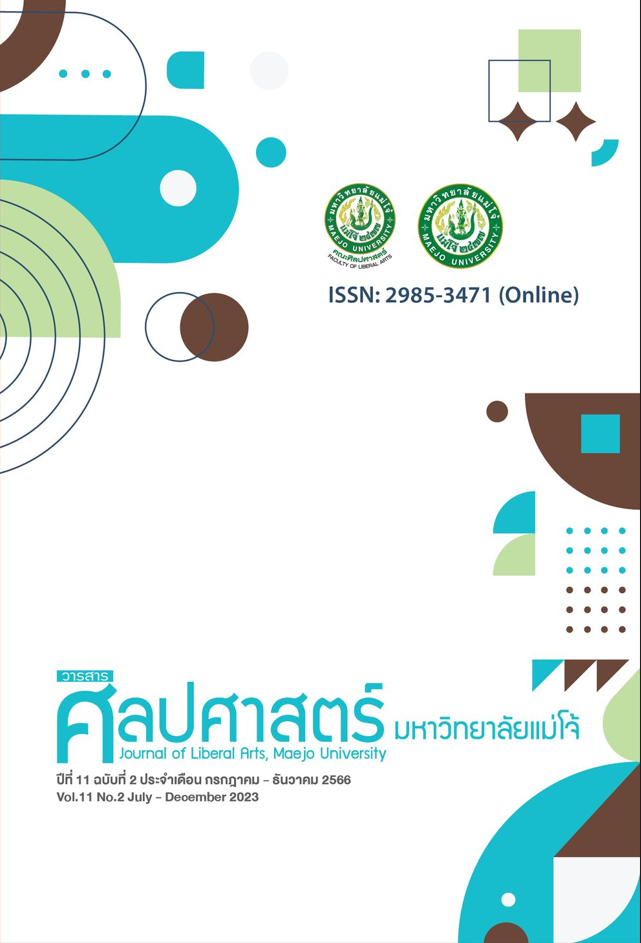Ma Sep Nang Talisman: Communication for Cultural Transmission of Lanna Amulets
Main Article Content
Abstract
The study aimed to explore cultural communication as a means to preserve the traditions of Lanna amulets, particularly focusing on the Ma Sep Nang talisman. Employing a qualitative research methodology grounded in the concepts of cultural production and reproduction, the researcher conducted in-depth interviews with producer groups, publisher groups, and consumer groups. Additionally, document analysis was employed to enrich the study. The research findings revealed that the Ma Sep Nang talisman was originally influenced by Burmese and Tai Yai cultures, subsequently undergoing modifications to evolve into the Lanna Yant Cloth. In the traditional era, the talisman symbolized love, charm, mercy, great popularity, and wealth, a significance that persisted into the contemporary era. However, an additional aspect emerged, focusing on attracting love. The study identified three characteristics of reproduced culture: existence, reproductive existence, and forward existence. During reproduction, the Ma Sep Nang talisman exhibited characteristics that either remained unchanged or were altered based on the creators' preferences and beliefs, leading to shifts in its intended purposes. Regarding consumption, individuals utilized the Ma Sep Nang talisman for various personal reasons, such as charm, trade, gambling, or seeking peace of mind. Consumers adapted the talisman to meet their specific needs, unrelated to its
primary effects. The dissemination of the Ma Sep Nang talisman style manifested through three distinct characteristics: the author, sellers, and collectors.
Article Details

This work is licensed under a Creative Commons Attribution-NonCommercial-NoDerivatives 4.0 International License.
ต้นฉบับที่ได้รับการตีพิมพ์ในวารสารคณะศิลปศาสตร์ มหาวิทยาลัยแม่โจ้ ถือเป็นกรรมสิทธิ์ของมหาวิทยาลัยแม่โจ้ ห้ามนำข้อความทั้งหมดหรือบางส่วนไปพิมพ์ซ้ำ เว้นเสียแต่จะได้รับอนุญาตจากมหาวิทยาลัยฯ เป็นลายลักษณ์อักษรReferences
กาญจนา แก้วเทพ. (2548). สื่อพื้นบ้านการพัฒนาภาพรวมจากวิจัย. กรุงเทพฯ : สำนักงานกองทุนสนับสนุนการวิจัย.
กาญจนา แก้วเทพ. (2549). เมื่อพิธีกรรมเป็นลำนําแห่งความสุข“ในยึดหลักปักแน่นกับสื่อพื้นบ้านสื่อสารสุขภาพ”โครงการสื่อพื้นบ้านสื่อสารสุข สํานักงานกองทุน สนับสนุนการสร้างเสริมสุขภาพ (สสส.). กรุงเทพฯ : โรงพิมพ์มหาวิทยาลัยธรรมศาสตร์.
กาญจนา แก้วเทพ และสมสุข หินวิมาน. (2551). สายธารแห่งนักคิดทฤษฎีเศรษฐศาสตร์การเมืองกับสื่อสารศึกษา.กรุงเทพฯ : ห้างหุ้นส่วนจำกัดภาพพิมพ์.
กาญจนา แก้วเทพ. (2556). กระบวนทัศน์ใหม่ของสื่อสารศึกษาไทย (รายงานการวิจัย). กรุงเทพ: สำนักงานกองทุนสนับสนุนการวิจัย. สืบค้นจาก https://dric.nrct.go.th/Search/ShowFulltext/2/287521
กาญจนา แก้วเทพ และสมสุข หินวิมาน. (2560). สายธารแห่งนักคิดทฤษฎีเศรษฐศาสตร์การเมืองกับสื่อสารศึกษา. พิมพ์ครั้งที่ 2. กรุงเทพฯ: สำนักพิมพ์อินทนิล.
กิตติ ภิญโญ. (2560). ปัจจัยที่ส่งผลต่อความนิยมพระเครื่องของประชาชนที่มีความสนใจพระเครื่องในจังหวัดกรุงเทพมหานคร กรณีศึกษา ศูนย์พระเครื่อง ห้างสรรพสินค้าพันธุ์ทิพย์พลาซ่า สาขางามวงศ์วาน (การค้นคว้าอิสระนิเทศศาสตรมหาบัณฑิต) ปทุมธานี: มหาวิทยาลัยกรุงเทพ. สืบค้นจาก http://dspace.bu. ac.th/handle/1 23456789/2993
ชัยมงคล อุดมทรัพย์ (ญาณโชติ). (2539). คัมภีร์ไสยศาสตร์ฉบับสมบูรณ์. กรุงเทพฯ: ศิลปาบรรณาคาร.
ณัฐธัญ มณีรัตน์. (2551). อิทธิพลของพุทธศาสนามหายานที่มีต่อระบบยันต์ในประเทศไทย (วิทยานิพนธ์ศิลปศาสตรมหาบัณฑิต) กรุงเทพฯ: มหาวิทยาลัยธรรมศาสตร์. สืบค้นจาก https://digital.library.tu.ac.th/tu_dc/ frontend/Info/item/dc:110371
ธวัช ปุณโณทก. (2530). “ความเชื่อพื้นบ้านอันสัมพันธ์กับวิถีชีวิตในสังคมอีสาน” ในวัฒนธรรมพื้นบ้านคติความเชื่อ. พิมพ์ครั้งที่ 3. กรุงเทพฯ: จุฬาลงกรณ์มหาวิทยาลัย.
ธิดารัตน์ รักประยูร. (2545). การเผยแพร่วัฒนธรรมวัยรุ่นญี่ปุ่นผ่านสื่อในประเทศไทย (วิทยานิพนธ์นิเทศศาสตรมหาบัณฑิต). กรุงเทพฯ: จุฬาลงกรณ์มหาวิทยาลัย.
ตำนานเครื่องรางของขลังไทย. (2561). สืบค้น 5 ตุลาคม 2563, จาก https://mahaniyom99.blogspot.com /2018/ 04/blog-post_78.html
วิลักษณ์ ศรีป่าซาง. (2558ก). คง เข้ม ข่าม ขลัง เครื่องรางล้านนา. กรุงเทพฯ: ณ บ้านวรรณกรรมกรุ๊ป จำกัด.
__________. (2558ข). คง เข้ม ข่าม ขลังเครื่องรางล้านนา. วารสารราชมงคลล้านนา, 3(1), 13-27. สืบค้นจาก https://so05.tci thaijo.org/index.php/balajhss/article/view/75181
เสถียร พันธรังษี. (2546). ศาสนาเปรียบเทียบ. พิมพ์ครั้งที่ 8. กรุงเทพฯ: สำนักพิมพ์สุขภาพใจ.
อธิคม โกมลวิทยาธร. (2538). วัฒนธรรมการบริโภค: แนวคิดและการวิเคราะห์. กรุงเทพฯ: ศูนย์วิจัยและผลิตตำรา มหาวิทยาลัยเกริก.
อุดม รุ่งเรืองศรี. (2547). พจนานุกรมล้านนา-ไทย ฉบับแม่ฟ้าหลวง. เชียงใหม่: โรงพิมพ์มิ่งเมือง
เอกวสา สุขส่ง. (2565). เปิดใจสายมูยุคดิจิทัลมาแรงแต่ทำไมคนยุคใหม่ยังอินเรื่องดวง. สืบค้น 12 พฤษภาคม 2565, จาก https://www.thairath.co.th/lifestyle/life/2294431

